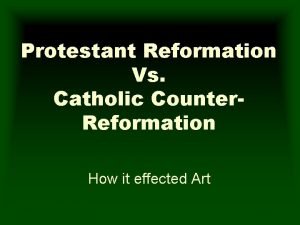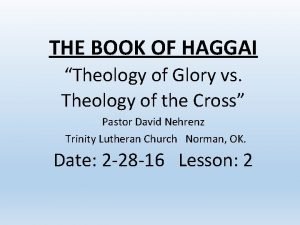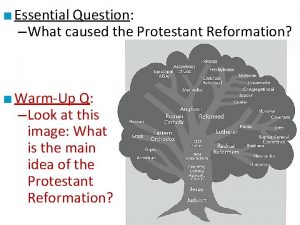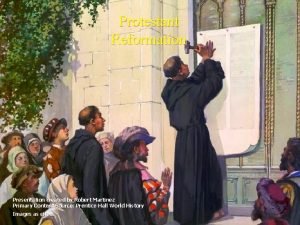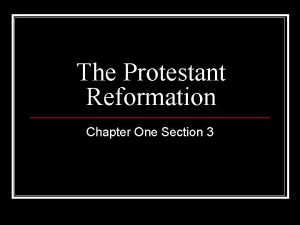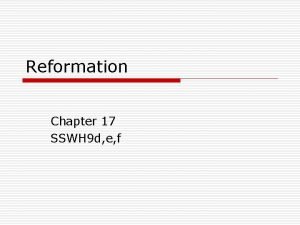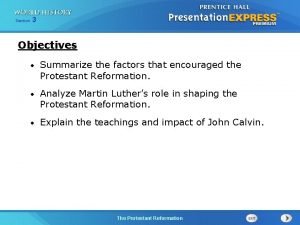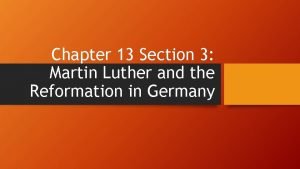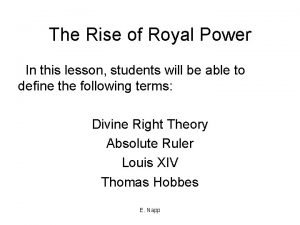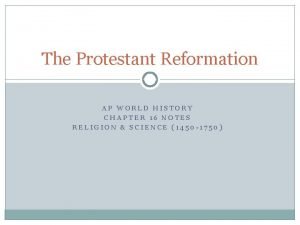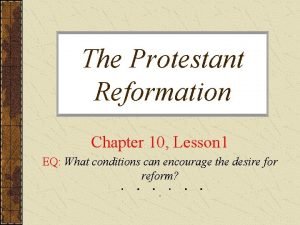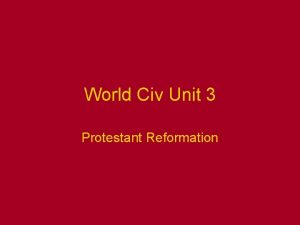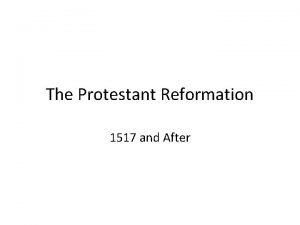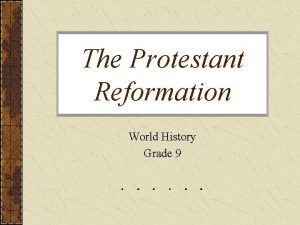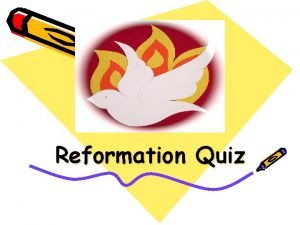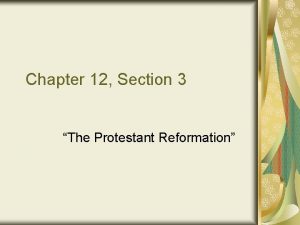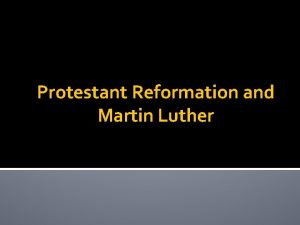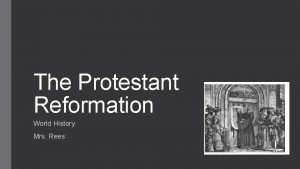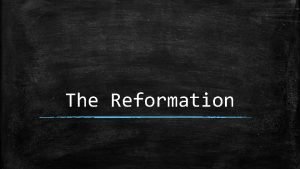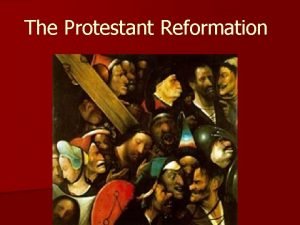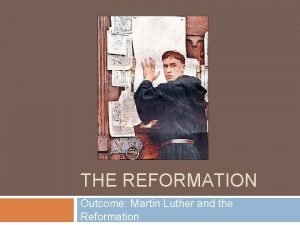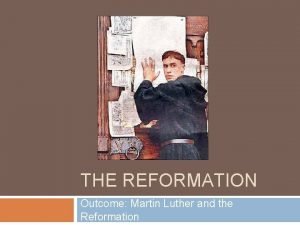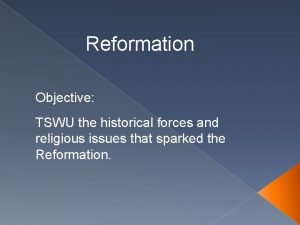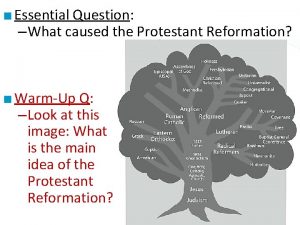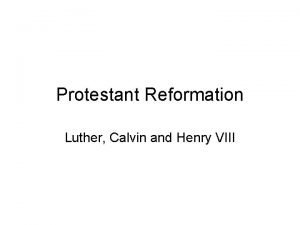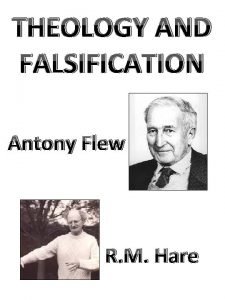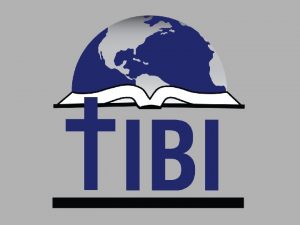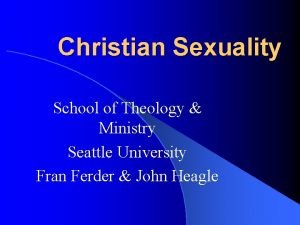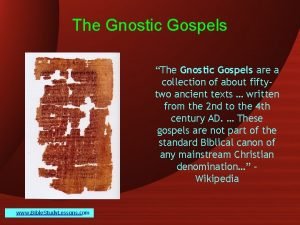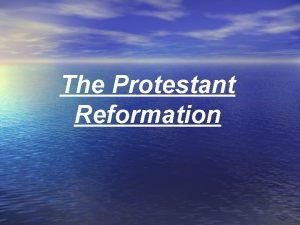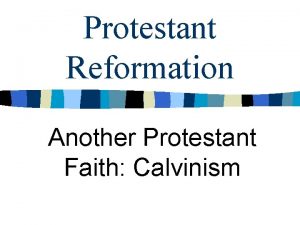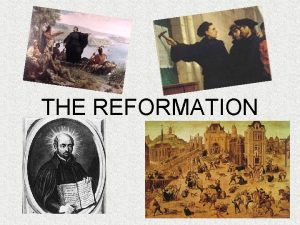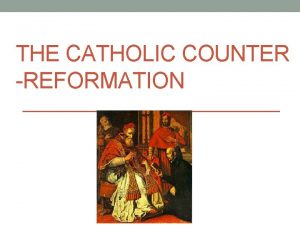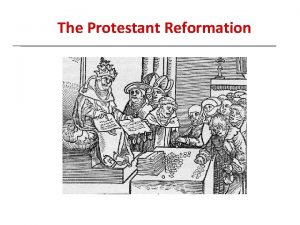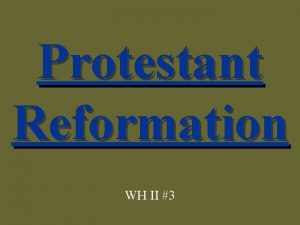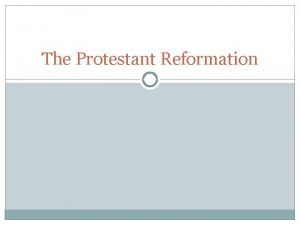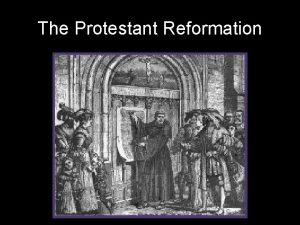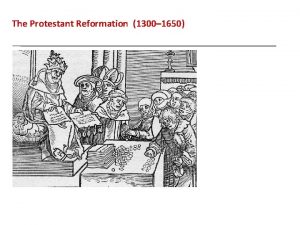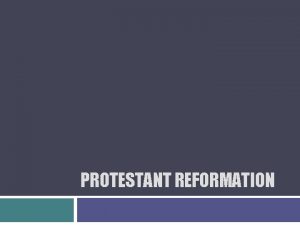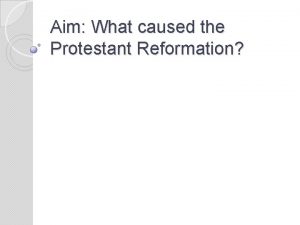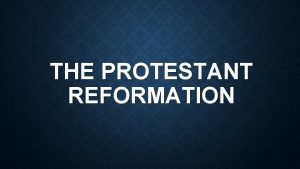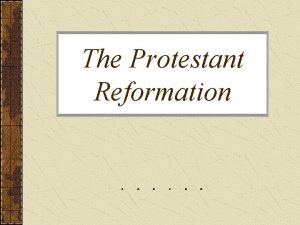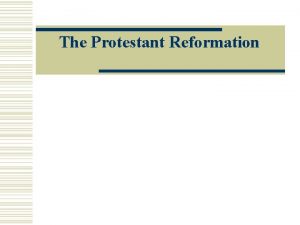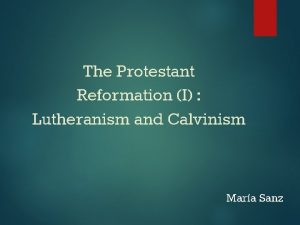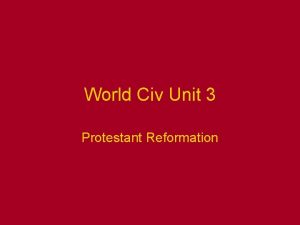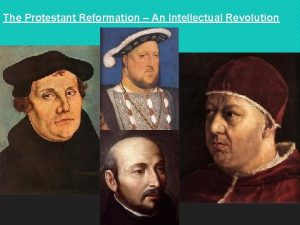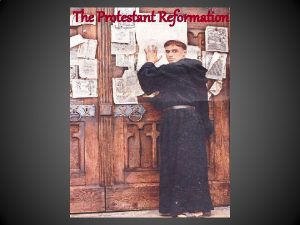Comparative Theology of the Protestant Reformation Lutheranism Lutheranism


































- Slides: 34

Comparative Theology of the Protestant Reformation

Lutheranism • Lutheranism was the first of the Reformation movements • He became an Augustine monk in 1505 • In 1508, he became a teacher of theology at the University of Wittenberg

• Luther concluded that the only path to salvation was through faith in the goodness and mercy of Jesus • There was nothing a believer could do to earn salvation • Only Jesus could grant the gift of salvation • Theology based on “salvation by faith alone”

• In 1517, Johann Tetzel began to sell indulgences in the area around Wittenberg • By gaining indulgences, Christians could reduce the amount of time they or their deceased loved ones would remain in purgatory before entering into heaven • $ being raised was being used to build St. Peters in Rome

• Luther began to question the doctrine of indulgences • October 31, 1517, he posted the 95 Theses on the door of the castle church in Wittenberg • Intended to be a challenge to debate the issue of indulgences • Luther was excommunicated by Pope Leo X in 1520

• In 1521, the Holy Roman Emperor Charles V ordered Luther to appear before the Diet of the Holy Roman Empire at its meeting in Worms • They called on him to recant, which he did not • Luther was declared an outlaw, but Frederick the Wise of Saxony provided him refuge

• In 1522, Luther returned to Wittenberg and began to reform the local church • Taught the only valid source of Christian doctrine was the Bible • Only 2 sacraments – baptism and communion • Priesthood for all believers

• Luther prepared German translation of the New Testament • Also abolished monasteries and ended the requirement for celibacy of the clergy • Services were less elaborate than Catholic worship

• In 1524, revolt against the landowners began among the peasants in southwestern Germany • The peasants sought to abolish serfdom and the manorial system • The peasants hoped for Luther’s support, but the he was a conservative on social and economic issues • He supported the princes suppressing the revolt

• In 1530, Luther appeared before Charles V at the Diet of Augsburg • He presented his statement of faith, which the Diet found unacceptable • A number of German Lutheran princes and cities established the Schmalkaldic League, an alliance against the Catholic Hapsburgs

• From 1546 to 1555, Germany was torn by a religious civil war • In 1555, the Peace of Augsburg was reached • German princes had the right to determine the religion of his state • Did not provide for recognition of other groups

• Lutheranism became the predominant religion in much of Germany • Spread to Scandinavia, becoming predominant in Denmark and Norway

Zwingli • Ulrich Zwingli began the Swiss Reformation • He was a humanist and Catholic priest, and had hoped that the Church would reform itself • Broke from the Church in 1519

• Believed in the supremacy of the Bible • Believed that baptism and communion were ceremonies were symbols, not true sacraments • Rejected the celibacy of the church • Emphasized simplicity in worship

John Calvin • Born in France • Studied theology and law • Began to develop his own views on the Christian religion • Was forced into exile and settled in Geneva, where he became the leader of that cities Reformation

• Set forth his theology in The Institutes of the Christian Religion • Bible was the only source of Christian doctrine • Only 2 sacraments, baptism and holy communion

• Emphasized the doctrine of predestination • At the beginning of creation, the all powerful and all knowing God had planned the whole universe to the end of time • God determined those individuals who would be saved

• Those destined for salvation were called the Elect • God had given the Elect a faith in Jesus Christ and a desire to live in accordance with Christian moral values

• Calvin ended both monasticism and the celibacy of the clergy • Worship emphasized simplicity • Worship consisted of prayers, the singing of psalms, scripture readings, and a sermon • Governed by laymen called elders, who were elected by the congregation

• Emphasized a puritanical approach to life • Required church attendance • Banned card playing, gambling, dancing, theatergoing, the consumption of alcohol and swearing • Calvin established a strict theocracy in Geneva

• The Calvinist Reformed Church became dominant in much of Switzerland • Those who practiced Calvinism in France were called Huguenots • John Knox spread Calvinism to Scotland (Presbyterianism) • English Calvinists are Puritans • Also won favor in the Dutch Netherlands

Anglicanism • Henry VIII wished to secure an annulment of his marriage to Catherine of Aragon • The king requested Pope Clement VIII to grant him the annulment on the claim that the marriage was invalid • Italy was being dominated at the time by Charles V, Catherine of Aragon’s nephew

• In 1529, Henry VIII dismissed his lord chancellor, Cardinal Wolsey and replaced him with Thomas More • The new archbishop of Canterbury, Thomas Cranmer, granted the annulment in 1533 • Henry married Anne Boleyn

• 1534, Parliament passed the Act of Supremacy • Declared the king, rather than the pope, to be the head of the English church • The English church under Henry VIII remained fundamentally Catholic

• In 1539, Parliament approved the Six Articles, defining the doctrine of the Catholic Church • On all major points, except papal supremacy, the Six Articles reaffirmed Catholic teaching and rejected Protestant beliefs

• Henry VIII acted against the English monasteries, which were regarded as strongholds of support for the papacy • The king needed money, sold most of the monastic lands to wealthy Englishmen

• Henry VIII encountered some opposition to his break with Rome • Thomas More refused to support the Act of Supremacy, and was executed • 1536 – Pilgrimage of Grace – conservative Northern part of England revolted against Henry

King Edward VI • Son of Henry VIII • During Edward’s reign, the English Church became more Protestant • Six Articles were replaced with Forty-two articles, which reflected more Calvinist ideas

Queen Mary • Followed Edward to the throne • Attempted to restore Roman Catholicism in England • Persecuted England’s Protestants

Queen Elizabeth I • Ruled after Mary • Tried to create a religious settlement that would satisfy the great majority of her subjects • 1559 – new Act of Supremacy • 1559 – Act of Uniformity • 1563 – Parliament defined the teachings of the Anglican Church with its Thirty-nine Articles

Anabaptism • Radicals of the Protestant Reformation • Rejected infant baptism • Insisted the only true Christians had undergone a conversion experience and had then been baptized

• Anabaptists opposed the taking of oaths and the bearing of arms • Believed that the church should be entirely separate from the state • Thomas Munzer – wanted religious reform but also wanted to overthrow the existing political and social order

• John of Leyden – headed a theocratic government in the city of Munster • Claimed to be directly inspired by God, he endorsed polygamy and took four wives

• Menno Simons was more moderate in his views • Became Anabaptist in 1536, preaching simplicity in religions practice and in life • Teaching resulted in the establishment of the Mennonite movement
 Protestants vs catholics
Protestants vs catholics Theology of glory vs theology of the cross
Theology of glory vs theology of the cross What caused the protestant reformation?
What caused the protestant reformation? Protestant reformation
Protestant reformation Why did the sale of indulgences become a critical issue
Why did the sale of indulgences become a critical issue Counter reformation def
Counter reformation def What factors encouraged the protestant reformation?
What factors encouraged the protestant reformation? Chapter 13 section 3 the protestant reformation
Chapter 13 section 3 the protestant reformation Protestant reformation
Protestant reformation Kaozheng ap world history
Kaozheng ap world history Chapter 16 lesson 1 the protestant reformation answer key
Chapter 16 lesson 1 the protestant reformation answer key Unit 3: martin luther & the protestant reformation
Unit 3: martin luther & the protestant reformation Unit 3 martin luther and the protestant reformation
Unit 3 martin luther and the protestant reformation Protestant reformation map
Protestant reformation map Crash course protestant reformation
Crash course protestant reformation Protestant reformation quiz
Protestant reformation quiz Unit 12 lesson 3 the protestant reformation
Unit 12 lesson 3 the protestant reformation Why did martin luther criticize the roman catholic church
Why did martin luther criticize the roman catholic church Protestant reformation cartoon
Protestant reformation cartoon Protestant reformation kahoot
Protestant reformation kahoot The protestant reformation crossword puzzle
The protestant reformation crossword puzzle The reformation outcome martin luther and the reformation
The reformation outcome martin luther and the reformation The reformation outcome martin luther and the reformation
The reformation outcome martin luther and the reformation Topic 4 the renaissance and reformation
Topic 4 the renaissance and reformation Calvinism vs lutheranism chart
Calvinism vs lutheranism chart Lutheranism beliefs
Lutheranism beliefs Protestant christian beliefs
Protestant christian beliefs Lutheranism def
Lutheranism def Theology of missions
Theology of missions Antony flew falsification
Antony flew falsification Practical theology mpt
Practical theology mpt Seattle university school of theology and ministry
Seattle university school of theology and ministry Basil mitchell parable of the partisan
Basil mitchell parable of the partisan Gnostic gospels summary
Gnostic gospels summary Mike mazzalongo church
Mike mazzalongo church
